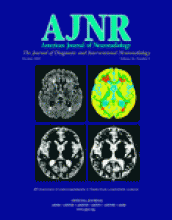OtherBRAIN
Prediction of Hemorrhage in Acute Ischemic Stroke Using Permeability MR Imaging
Andrea Kassner, Timothy Roberts, Keri Taylor, Frank Silver and David Mikulis
American Journal of Neuroradiology October 2005, 26 (9) 2213-2217;
Andrea Kassner
Timothy Roberts
Keri Taylor
Frank Silver

References
- ↵del Zoppo GJ, von Kummer R, Hamann GF. Ischaemic damage of brain microvessels: inherent risks for thrombolytic treatment in stroke. J Neurol Neurosurg Psychiatry 1998;65:1–9
- ↵Lyden PD, Zivin JA. Hemorrhagic transformation after cerebral ischemia: mechanisms and incidence. Cerebrovasc Brain Metab Rev 1993;5:1–16
- ↵The NINDS t-PA Stroke Study Group. Intracerebral hemorrhage after intravenous t-PA therapy for ischemic stroke. Stroke 1997;28:2109–2118
- ↵Larrue V, von Kummer R, del Zoppo G, Bluhmki E. Hemorrhagic transformation in acute ischemic stroke: potential contributing factors in the European Cooperative Acute Stroke Study. Stroke 1997;28:957–960
- ↵Toni D, Fiorelli M, Bastianello S, et al. Hemorrhagic transformation of brain infarct: predictability in the first 5 hours from stroke onset and influence on clinical outcome. Neurology 1996;46:41–45
- ↵Jaillard A, Cornu C, Durieux A, et al, for the MAST-E Group. Hemorrhagic transformation in acute ischemic stroke: the MAST-E study. Stroke 1999;30:1326–1332
- The Multicenter Acute Stroke Trial-Europe Study Group. Thrombolytic therapy with streptokinase in acute ischemic stroke. N Engl J Med 1996;335:145–150
- Hacke W, Kaste M, Fieschi C, et al, for the ECASS Study Group. Intravenous thrombolysis with recombinant tissue plasminogen activator for acute hemispheric stroke: the European Cooperative Acute Stroke Study (ECASS). JAMA 1995;274:1017–1025
- ↵Hacke W, Kaste M, Fieschi C, et al, for the Second European-Australasian Acute Stroke Study Investigators. Randomised double-blind placebo-controlled trial of thrombolytic therapy with intravenous alteplase in acute ischaemic stroke (ECASS II). Lancet 1998;352:1245–1251
- ↵Baron JC, von Kummer R, del Zoppo GJ. Treatment of acute ischemic stroke: challenging the concept of a rigid and universal time window. Stroke 1999;30:180–182
- ↵Roberts HC, Roberts TP, Bollen AW, et al. Correlation of microvascular permeability derived from dynamic contrast-enhanced MR imaging with histologic grade and tumor labeling index: a study in human brain tumors. AJNR Am J Neuroradiol 2001;21:891–899
- ↵Kidwell CS, Chalea JA, Saver JL, et al. Comparison of MRI and CT for detection of acute intracerebral hemorrhage. JAMA 2004;292(15):1823–1830
- ↵The NINDS t-PA Stroke Study Group. Intracerebral hemorrhage after intravenous t-PA therapy for ischemic stroke. Stroke 1997;28:2109–2118
- ↵Kassner A, Roberts TPL, Taylor K, Silver F, Mikulis DJ. Detection of blood-brain barrier leakage in early acute stroke using dynamic contrast-enhanced MR imaging. Book of Abstracts, 42nd Annual Meeting of the American Society of Neuroradiology,2004;227
- ↵Yepes M, Sandkvist M, Moore EG, Bugge TH, Strickland DK, Lawrence DA. Tissue-type plasminogen activator induces opening of the blood-brain-barrier via the LDL receptor-related protein. J Clin Invest 2003;112:1533–1540
In this issue
Advertisement
Andrea Kassner, Timothy Roberts, Keri Taylor, Frank Silver, David Mikulis
Prediction of Hemorrhage in Acute Ischemic Stroke Using Permeability MR Imaging
American Journal of Neuroradiology Oct 2005, 26 (9) 2213-2217;
0 Responses
Jump to section
Related Articles
- No related articles found.
Cited By...
- DCE-MRI blood-brain barrier assessment in acute ischemic stroke
- Assessment of Blood-Brain Barrier Disruption in Stroke
- What causes intracerebral bleeding after thrombolysis for acute ischaemic stroke? Recent insights into mechanisms and potential biomarkers
- Effects of Agmatine on Blood-Brain Barrier Stabilization Assessed by Permeability MRI in a Rat Model of Transient Cerebral Ischemia
- Effects of Microvascular Permeability Changes on Contrast-Enhanced T1 and Pharmacokinetic MR Imagings After Ischemia
- Magnetic Resonance Imaging Profile of Blood-Brain Barrier Injury in Patients With Acute Intracerebral Hemorrhage
- Breaking down barriers to identify hemorrhagic transformation in ischemic stroke
- Blood-Brain Barrier Permeability Assessed by Perfusion CT Predicts Symptomatic Hemorrhagic Transformation and Malignant Edema in Acute Ischemic Stroke
- Contrast-Enhanced MR Imaging in Acute Ischemic Stroke: T2* Measures of Blood-Brain Barrier Permeability and Their Relationship to T1 Estimates and Hemorrhagic Transformation
- Texture Analysis: A Review of Neurologic MR Imaging Applications
- Recombinant Tissue Plasminogen Activator Increases Blood-Brain Barrier Disruption in Acute Ischemic Stroke: An MR Imaging Permeability Study
- Optimal Duration of Acquisition for Dynamic Perfusion CT Assessment of Blood-Brain Barrier Permeability Using the Patlak Model
- Theoretic Basis and Technical Implementations of CT Perfusion in Acute Ischemic Stroke, Part 2: Technical Implementations
- Patterns and Predictors of Blood-Brain Barrier Permeability Derangements in Acute Ischemic Stroke
- Intracerebral haemorrhage after thrombolysis for acute ischaemic stroke: an update
- Elevated Serum S100B Levels Indicate a Higher Risk of Hemorrhagic Transformation After Thrombolytic Therapy in Acute Stroke
- Intracranial Hemorrhage Associated With Revascularization Therapies
This article has not yet been cited by articles in journals that are participating in Crossref Cited-by Linking.
More in this TOC Section
Similar Articles
Advertisement











